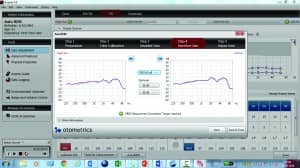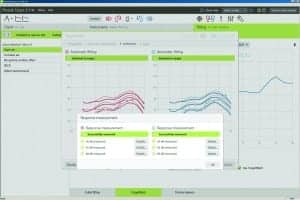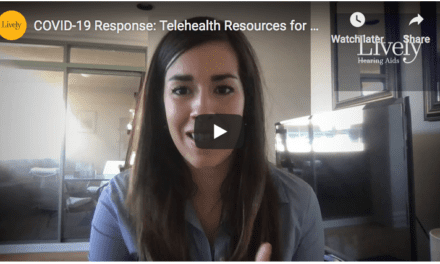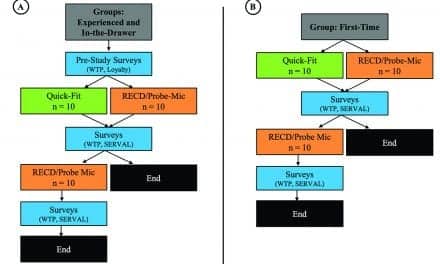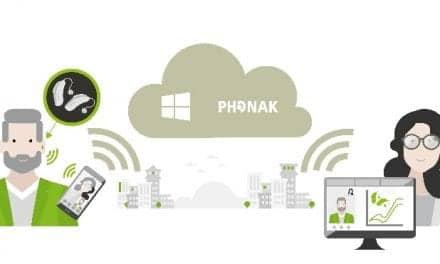Tech Topic | December 2017 Hearing Review
Teleaudiology becomes increasingly important as the evolution of healthcare to a reliance on electronic health records (EHRs) continues.
Not long ago, my cousin and I were visiting with my uncle, a Vietnam War veteran, who was recently fit with his second set of hearing aids from the Veterans Administration (VA). I noticed that he wasn’t following the conversation as well as he should, especially when trying to understand my cousin who has a soft, high-pitched voice. He noticed it too, so he immediately reached into his pocket for his iPhone and adjusted the volume in a somewhat successful attempt to hear us better. I asked to see the phone, as I wanted to check out the app. He readily obliged. As I discovered, not only can he adjust the volume (binaurally or left/right independently), but he can also adjust bass and treble (which I turned up), noise reduction, and several other features. While my uncle and I both found this to have a “cool” factor, it also proved to be helpful in his ability to follow the conversation and actively participate.
What a long way we have come as a profession in our technological advances—not only with hearing instruments but with all aspects of the profession. From diagnostic testing to patient scheduling, documentation, reporting and marketing, the devices and software we utilize on a daily basis have, for the most part, made our clinical lives markedly better.
However, as we all know, those advantages can quickly turn to disadvantages or be underutilized and are sometimes difficult to adopt. So, where are we as a profession in this digital world of ours and what questions should we be asking to help ensure we stay relevant?
Transitioning to Electronic Records
As George Bernard Shaw said, “Progress is impossible without change,” and in terms of the electronic or digital push, our federal government decided years ago that change was in order for our healthcare systems nationwide. The passing of the Health Insurance Portability and Accountability Act (HIPAA) in 1996 ushered in changes to how medical records were handled. This law was introduced to address growing concerns over healthcare coverage, privacy, and security.
HIPAA addressed not only hard-copy patient records but also the increasing emergence of electronic medical records. Further mandates and funding were introduced by the federal government in the early 2000s, calling for the entire medical industry to adopt electronic medical records by 2014.
As part of the American Recovery and Reinvestment Act of 2009, further incentives and requirements were introduced in order to move us fully to electronic medical records (EMR). Depending on the type and setting of the hearing care practice, all or part of the patient journey can (and in many places, must) be integrated with EMR. However, much progress remains to be accomplished. Thankfully, numerous companies are providing solutions to help with the EMR transition.
Why is there such a push from the federal government and our medical institutions to move toward electronic health records (EHR) and EMR? The answer can be found in the Centers for Medicare and Medicaid Services’ description of “Meaningful Use.”1 According to HealthIT.gov, these include improving the quality, safety, and efficiency of healthcare, as well as to reduce health disparities. The intent is also to engage patients and family as well as to improve care coordination while maintaining the privacy and security of patient health information.
Storing of such patient data also lends itself to more robust data research which, in turn, allows healthcare providers to make evidence-based decisions about how healthcare is delivered. Unfortunately, audiologists and hearing instrument specialists are not currently part of the defined professions that can receive federal incentives to meet the goals of EHR. However, in order to effectively interact with hospitals and physicians, we need to meet the same standards and, obviously, the goals of EHR also serve our profession—whether or not the federal government incentivizes us to meet them. We also know that our patients expect a certain level of care in a timely manner, and the digital world is part of their everyday experience.
Real-time Expectations in the Age of Apps
In 2016, approximately 198.5 million people in the United States owned smartphones, according to comScore.com.2 The US population in 2016 was estimated to be approximately 324 million people.3 So, more than 61% of the US population utilize smartphones—and that number is increasing. Google Play has over 2.2 million apps to use on those smartphones and Apple has approximately 2 million apps.4 According to a 2016 Accenture survey, the number of people utilizing health apps doubled between 2014 and 2016 (16% to 33%).5 The Accenture study further noted that many consumers are willing to share wearable or app data with their physician (90%) or nurse (87%), and that 40% of those surveyed had already done so at the time of the questionnaire.
As mentioned previously in my encounter with my uncle and his hearing aids, we know that these apps are an ever-increasing presence in the hearing healthcare world. Currently, there are hundreds of apps available for those with hearing loss. There are, of course, the apps created by the hearing aid manufacturers for use with their hearing aids, but there are also apps for hearing screening, TV amplification, tinnitus relief, hearing loss simulation, and much more. For an excellent list of hearing-related apps, see the article “70+ Best Hearing Loss and Tinnitus Apps For Your Ears” by Lindsey Banks.6 As patient interest increases, so too will the proliferation of available apps.
We also know that our patients want access to their patient records, including their hearing tests. They want that access at their fingertips and at any time of day, and that’s simply not possible without EMR/EHR integration.
Serving More Patients with Teleaudiology
While hearing instrument apps are one aspect of how our profession is moving into the digital realm, we have introduced other tools as well. Teleaudiology—a growing subspecialty of the telemedicine trend—is one example of how dedicated professionals are utilizing technology to reach patients that may not otherwise be reached.
Figure 1 shows an example of a teleaudiology cart, with Otometrics’ equipment integrated with OTOsuite software. This integration enables clinicians to help patients in remote areas. Teleaudiology minimizes the patient’s or caregiver’s time away from work, reduces their costs, and increases access to specialists. Consider the advantages for those patients who live in rural areas or those with limited means to physically reach a healthcare center—teleaudiology can mean the difference between good hearing health or not.
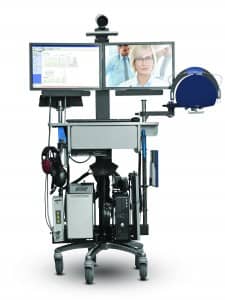
Figure 1. The teleaudiology cart with Otometrics equipment integrated with the OTOsuite software is a practical example of how integration enables clinicians to help patients in remote areas.
It’s not just the VA and other large institutions that are adopting teleaudiology. Some private hearing clinics are utilizing the ability of digital products to reach their patients remotely. Consider the ReSound Assist, which allows patients to contact their hearing care provider via the cloud and request programming changes to their hearing instruments. This growing trend demands the use of hardware and software products that are digitally integrated. Without digital access, teleaudiology simply doesn’t work.
Optimizing Workflows
Another example of our adoption of digital platforms is, of course, Noah. Hearing care providers who fit hearing instruments have all but universally adopted Noah, a platform that most of us are familiar with that provides us access to both audiometric and fitting information. It allows for the integration of patient information into one software platform, as well as a single portal to multiple hearing aid manufacturers’ programming software. Obviously, this has many benefits, including ease of use and efficiency in record keeping.
However, Noah also has its limitations, including the inability to interface with some diagnostic equipment and its limited reporting capabilities. Unfortunately, particularly in a diagnostic setting, this is where audiology often lags with EMR/EHR integration. As an example, some equipment may not allow for communication with Noah or other databases, so the results have to be printed and scanned in order to get them into a digital medium that can be uploaded to the office’s EMR/EHR system. As an alternative, the results can be summarized on a report, but may still lack specific test result information. The same may hold true for probe-microphone measures, ABR results, or vestibular testing results.
This creates a significant gap in our ability to share information and generally meet the “Meaningful Use” criteria. These types of disconnects between patient data and reporting also incur expenses—both in time spent scanning and storing, but also in the time taken away from patient counseling. In most busy clinics, time is a crucial asset and every additional available moment is precious. Time spent on menial tasks such as scanning could be better spent with the patient or marketing the practice.
Fortunately, diagnostic audiological equipment from some manufacturers incorporates the ability to allow for EMR/EHR integration while, at the same time, providing customized reporting features and patient counseling features. One such example is OTOsuite from Otometrics (http://www.audiologysystems.com/products/otosuite-integrated-software). OTOsuite was first introduced in 2007 as a way to integrate tympanometry and audiometry with patient counseling tools. In 2010, the Aurical FreeFit Probe Microphone Measurement (PMM) system was added and, in the years that followed, audiometers, OAE, Hearing Instrument Test (HIT) boxes, and newer tympanometers were also added. In 2015, OTObase, an easy-to-use patient management module, was made available to allow for direct integration of data to EMR/EHR systems. The integration of all these diagnostic tests in one software platform allows for a smooth patient test workflow, simplified reporting, as well as the ability to counsel the patient from one source or interface. The fact that information from various pieces of equipment doesn’t have to be printed and scanned into an EMR/EHR database also minimizes errors and omissions, reduces staffing costs, and increases the amount of time available for the professional to spend with their patient. One custom report also serves to improve the appearance of professionalism and facilitates communication with the patient. Another advantage of having the patient’s information in one software application is the ability to access that information across multiple work stations or even multiple physical sites. The data is readily available, yet secure, no matter where it’s accessed.
Making the Most of Your Equipment
If your clinic or practice is investing in new equipment, educate yourself on the benefits and limitations of that equipment’s capabilities. For example, understand what the equipment’s EMR/EHR integration capabilities, as well as its ability to grow with your practice. Can it smoothly translate data to the EMR/EHR or even navigate between different pieces of diagnostic or fitting equipment? Is it modular and can it keep up with the changes in your clinic? In other words, if you decide that in the beginning you only need an audiometer and a PMM system, can you later add tympanometry, OAE, or other diagnostic testing equipment that will easily incorporate into the current system?
If you are a fitting clinic, you may also ask the question of whether or not the equipment and software integrates well with hearing aid manufacturers’ software. As an example, OTOsuite recently incorporated an automated verification feature known as “Intermodular Communication, version 2” (IMC2), a HIMSA standard. IMC2 allows Aurical to communicate directly with hearing aid manufacturers’ software, allowing for an automated fit-to-target approach with included verification. IMC2 not only provides a professional fitting experience, but it also helps to reduce errors, ensure a successful fit, and minimizes the time needed to train on the equipment and software. IMC2, which was spearheaded by Otometrics, has become a recognized standard in the industry. As of this writing, 4 of the “Big 6” manufacturers have incorporated IMC2.
One of the commonly cited objections for not using PMM is the professional’s lack of training on the equipment or level of comfort with its use. Protocols such as IMC2 help to automate the steps in the PMM process, thereby minimizing these obstacles. Another common objection is the lack of confidence with insertion of the probe tube. This is reduced by using the “Probe Tube Assistant” which interactively guides the clinician to the correct probe-tube depth. For other hearing aid manufacturers not currently part of the IMC2 integration, the “OnTop mode” allows for concurrent visualization of both the fitting software and the PMM software, allowing for real-time programming changes relative to the probe-microphone response. Also, ask how hardware and software updates are achieved. For example, can equipment firmware updates be easily pushed through via software updates, allowing the equipment to stay current and relevant to your practice?
From a consulting perspective, your equipment and software should also allow for customized reports that can be used to provide information back to referring physicians or other professionals, educate the patient and family, and help grow your practice. Applications, such as OTOsuite and its companion software OTOsuite Reports, are designed to gather information from each piece of equipment (even if the equipment isn’t OTOsuite-compatible but is capable of printing to PDF) and distill it into one comprehensive and individualized report.
Finally, consider the suppliers’ ability to provide support throughout the lifespan of the product. For example, Audiology Systems offers services from its “Software Integration Group (SIG),” which include EMR/EHR consulting, Noah networking/support, and database security, among others. This consultative group can assess your individual clinic needs and make recommendations accordingly. This may change as your clinic grows.
Conclusion
With advances in diagnostic hardware and software, patient management systems, and hearing instrument software and hardware, the hearing industry has begun to establish our place in the healthcare digital space. Our goals are universal quality and expert care for our patients, while at the same time allowing adherence to EMR/EHR guidelines and remaining relevant and competitive. However, much work remains, and with the changing landscape and challenges inherent to our healthcare system, the need for informed and progressive professionals to assist you and your practice will continue.
Correspondence can be addressed to Otometrics/Audiology Systems’ Wendy Switalski, AuD, at: [email protected]
Original citation for this article: Flores A. Connecting the dots in the digital hearing healthcare landscape. Hearing Review. 2017;24(12):36-38.
Biography: Angela Flores, AuD, is an independent audiology consultant for Otometrics/Audiology Systems. She has worked clinically with both pediatric and adult populations providing a wide array of audiology services. In her more recent roles she has managed or supported training and marketing teams for equipment and hearing aid manufacturers.
References
-
HealthIT.gov. Meaningful Use Definition & Objectives. Available at: https://www.healthit.gov/providers-professionals/meaningful-use-definition-objectives
-
comScore.com. ComScore Reports January 2016 US Smartphone Subscriber Market Share. Reston, Va: comScore.com. March 4, 2016. Available at: https://www.comscore.com/Insights/Rankings/comScore-Reports-January-2016-US-Smartphone-Subscriber-Market-Share
-
Worldometers. US population. http://www.worldometers.info/world-population/us-population/
-
Rahis S. The 2017 mobile app market: Statistics, trends, and analysis. January 6, 2017. Available at: http://www.business2community.com/mobile-apps/2017-mobile-app-market-statistics-trends-analysis-01750346#zWu4v8uv3HL7MUfC.99
-
Accenture Consulting. Patients want a heavy dose of digital. 2016. Available at: https://www.accenture.com/t20160629T045303__w__/us-en/_acnmedia/PDF-6/Accenture-Patients-Want-A-Heavy-Dose-of-Digital-Infographic.pdf#zoom=50
-
Banks L. 70+ best hearing loss and tinnitus apps for your ears. February 11, 2017. Available at: https://www.everydayhearing.com/hearing-technology/articles/hearing-loss-tinnitus-apps/


